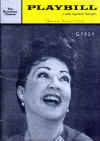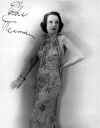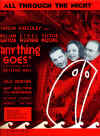Merman 101
Ethel Merman: A Brief Biography
by John Kenrick
(Copyright 2002)
(The images below are thumbnails – click on them to see larger versions.)
 Ethel Merman,
b. Jan. 16, 1908 (Astoria, NY) - d. Feb. 15, 1984 (NYC)
Ethel Merman,
b. Jan. 16, 1908 (Astoria, NY) - d. Feb. 15, 1984 (NYC)
Ethel Agnes Zimmerman was born in the third floor bedroom of her grandmother's house at 359 4th Avenue in Astoria, Queens. Growing up near Famous Players-Lasky's Astoria Studios, young Ethel often watched the silent movie stars drive by in their massive cars, and she dreamed of joining their ranks one day. Her powerful voice won attention when her family worshipped at Holy Redeemer Episcopal Church, and she began making local concert appearances. She also frequently attended vaudeville performances at The Palace Theater in Manhattan, watching great stars like Fanny Brice and Sophie Tucker.
Ethel's parents Edward (an accountant) and Agnes (a school teacher) understood Ethel's love of singing, but they did not see show business as a reliable career choice for a woman. They insisted that she get a solid education with thorough training in secretarial skills, so she would have something to fall back on if her dreams of stardom didn't pan out. After Ethel graduating William Cullen Bryant High School, she earned a respectable $28 a week as a stenographer for the owner of a local factory. She picked up extra money by singing at private parties and in night clubs. Ethel was so efficient that her indulgent boss (who only came in two days a week) overlooked her taking nap breaks at the office after late night performances. When Ethel's gigs multiplied, her parents accepted the inevitable and allowed her to give up the day job and sing full-time.
 Merman
in an early autographed photo.
Merman
in an early autographed photo.
In a surprise development, Warner Brothers put young Merman under contract at $200 a week. But those were the early days of sound film, when all of the studios were in a state of confusion. After months of paid inactivity, Ethel got a release so she could accept live engagements. At about this time, she abbreviated her last name to "Merman" so it would fit more easily into newspaper ads and theater marquees.
At the same time, Ethel began working with Al Siegel, an accompanist who had worked with several prominent torch singers. In later years, Siegel would claim that he "made Merman a star" – a suggestion Merman would always deny. While it is clear that Siegel helped her select better material and found ways to show it off with exciting arrangements, it is ludicrous to suggest that Merman owed her unique qualities as a performer to anyone other than herself. Ethel's career skyrocketed after she and Siegel parted ways the following year, which makes his claims seem all the more laughable.
A serious case of tonsillitis in 1929 caused some worry, but somehow left Merman's voice louder than ever. With her earthy style and powerhouse pipes restored, Merman was ready for her shot at the big time.
Big Break: "I Got Rhythm"
In 1930, Merman was performing songs between film screenings at the Brooklyn Paramount Theatre. Broadway producer Vinton Freedley caught her act and was so impressed that he engaged her for his next musical – pending the approval of songwriters George and Ira Gershwin. The two brothers auditioned Merman, previewing "I Got Rhythm" and "Sam and Delilah" for her. When George misinterpreted Ethel's thoughtful expression as an indication of disapproval, he offered to change anything she didn't like in the songs. A flabbergasted Merman managed to blurt out, "They will do very nicely, Mr. Gershwin." This unintentional cockiness delighted the Gershwins, and marked the beginning of Merman's deserved reputation for self-assurance.
With the Gershwin musical in preparation, Merman filled in the time by making her debut at The Palace, America's high temple of vaudeville. Outstanding reviews provided the first hint that a new star was being born, but nothing could have prepared anyone for the opening night of Girl Crazy (1930 - 272). Merman's clarion rendition of "I Got Rhythm," which included belting a C note for sixteen exhilarating bars, left the audience demanding multiple encores. During the intermission, George Gershwin left the orchestra pit and charged up to her dressing room. "Ethel, do you know what you're doing?" he asked. When she replied in the negative, he said, "Well, never go near a singing teacher . . . and never forget your shorthand." Gershwin thought Merman's belting would blow out her voice in a short time. Ironically, he would be dead in six years, while Merman would sing full out for the next five decades.
 William
Gaxton, Ethel Merman and Victor Moore on the sheet music for "All
Through the Night" from Anything Goes.
William
Gaxton, Ethel Merman and Victor Moore on the sheet music for "All
Through the Night" from Anything Goes.
Merman stepped in to add some much needed star power to a shaky edition of George White's Scandals (1931), then stole the troubled Take A Chance (1932) with her crackling rendition of "Eadie Was a Lady." Winning fresh attention from Hollywood, she filmed the now forgotten We're Not Dressing (1934) with Bing Crosby and the daffy Kid Millions (1934) with Eddie Cantor. It was soon clear that the studios still had no clue what to do with Merman's unique talents, so she returned to Broadway.
With the Great Depression in full swing, producer Vinton Freedley needed a hit to restore his fortunes. He assembled a stellar team, raised the money, and guided the show through a tortuous series of revisions. When the script of Anything Goes (1934 - 420) was re-written during rehearsals, Ethel put her secretarial skills to good use by taking down dialogue as the authors improvised. She then typed out the material herself. (Just think how Actor's Equity would scream if an actor pitched in like that today!) Anything Goes overcame its improvised formation thanks to a funny low comedy script and a hit-laden Cole Porter score. As evangelist turned nightclub singer Reno Sweeney, Merman co-starred with veteran comic Victor Moore and suave leading man William Gaxton. She also got to introduce the topical title tune, the fanfare-like "Blow Gabriel Blow" and "I Get a Kick Out of You." She shared Porter's popular laundry-list song "You're the Top" with Gaxton, who became a lifelong friend.
Still hoping for screen stardom, Merman was the only leading member of the Broadway cast to appear in the film version of Anything Goes (1936) appearing with Bing Crosby. This watered-down adaptation tossed out most of the original score and "cleaned-up" the remaining Porter lyrics. (Many surviving prints use the British release title, Tops Is The Limit). The larger-than-life comic style that made Merman a favorite on stage was muffed for the camera, and while her youthful energy was appealing, she didn't have the glamorous looks Hollywood expected in a leading lady. Alexander's Ragtime Band (1938) gave Merman her first opportunity to work with songwriter Irving Berlin, but the best number he wrote for her ("Time Marches On") wound up on the cutting room floor, and her otherwise solid performance did not lead to other good screen roles, so Merman permanently refocused her energies on Broadway.
By the end of the 1930s, Merman's name on a New York theatre marquee guaranteed strong ticket sales, so every major producer and composer was vying for a chance to work with her. She closed out the decade with another Cole Porter hit, DuBarry was a Lady (1939 - 408). Co-star Bert Lahr played a washroom attendant in love with a singing star (Merman). Knocked out by a drugged cocktail, Lahr dreams that he is Louis XV, chasing mistress Madame DuBarry (also played by Merman) around Versailles. Merman and Lahr stopped the show with the bawdy "But in the Morning, No" and the popular hit "Friendship." Although the chronically insecure Lahr was somewhat intimidated by Merman's strength, they made an effective team on stage.
 While dreaming that he is King Louis XV of France, Bert Lahr
contemplates Ethel Merman's latest royal scheme in DuBarry Was a
Lady.
While dreaming that he is King Louis XV of France, Bert Lahr
contemplates Ethel Merman's latest royal scheme in DuBarry Was a
Lady.
Bert's Lahr offered his son this frank assessment of what it was like to work with Merman –
"She's an individual with a special way of working. There was nothing vicious in what she did, she is a great performer. But she's tough. She never looks at you on stage. She's got her tricks."
- as quoted by John Lahr in Notes on a Cowardly Lion (New York: Limelight, 1984), pp. 207-208.
Tricks? Of course – all comic stars had them, Lahr included. Merman's energy and undeniable talent made her a force of nature on stage. She was infamous for rarely looking fellow actors in the eye. She had only one focus while on stage – the audience. The results might not meet with the approval of acting teachers, but they delighted the ticket buying public. That is why Merman had become one Broadway's biggest stars in less than ten years. And she was just getting started.
